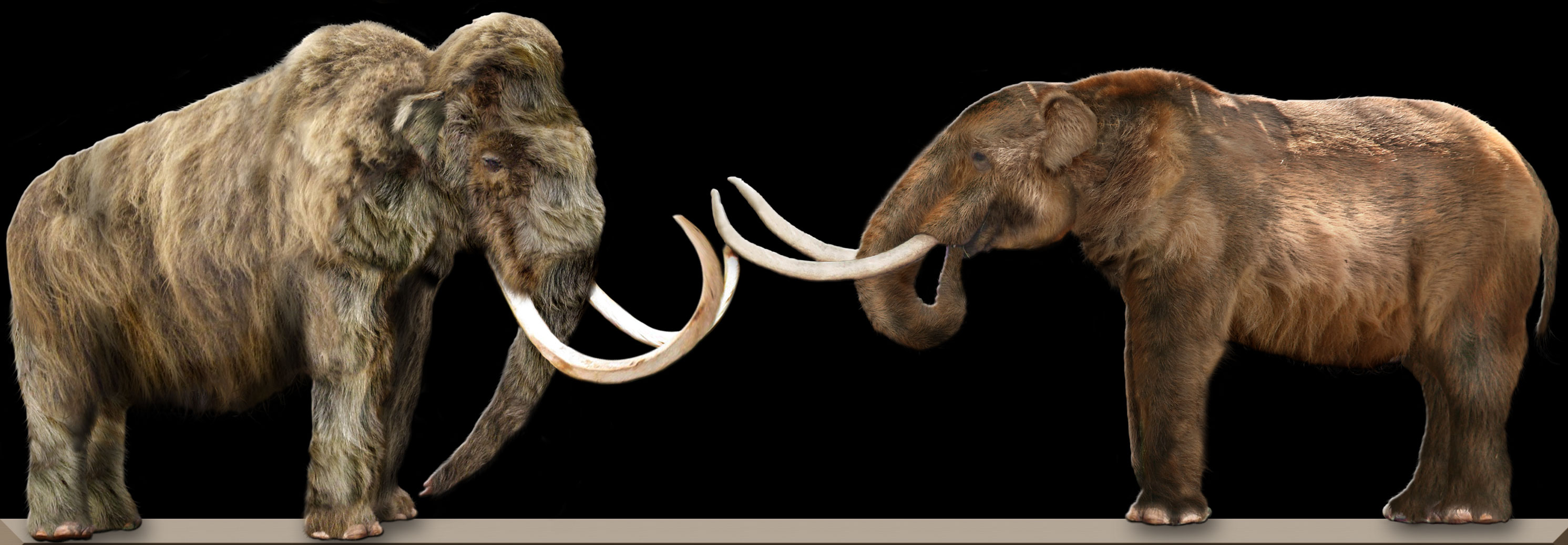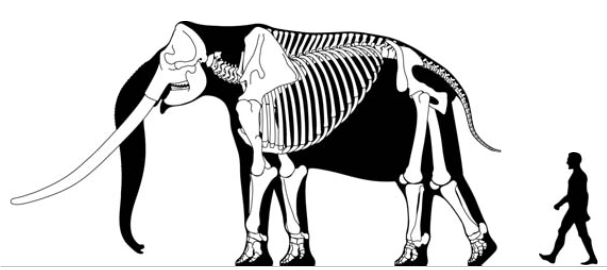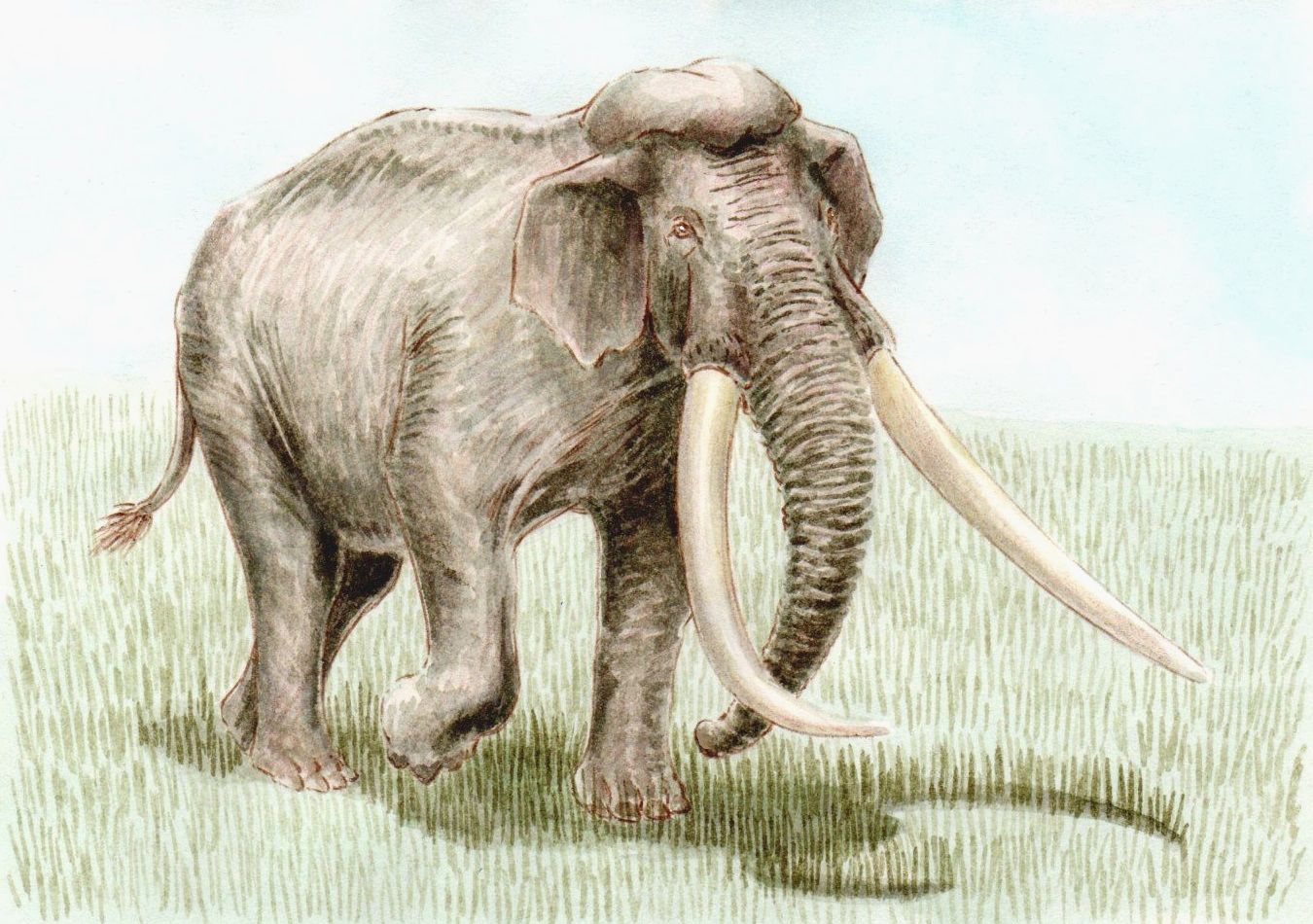|
Proboscideans
The Proboscidea (; , ) are a taxonomic order of afrotherian mammals containing one living family (Elephantidae) and several extinct families. First described by J. Illiger in 1811, it encompasses the elephants and their close relatives. From the mid-Miocene onwards, most proboscideans were very large. The largest land mammal of all time may have been a proboscidean; ''Palaeoloxodon namadicus'' was up to at the shoulder and may have weighed up to , almost double the weight of some sauropods like ''Diplodocus carnegii''. The largest extant proboscidean is the African bush elephant, with a record of size of at the shoulder and . In addition to their enormous size, later proboscideans are distinguished by tusks and long, muscular trunks, which were less developed or absent in early proboscideans. Three species of elephant are currently recognised: the African bush elephant, the African forest elephant, and the Asian elephant. Elephantidae is the only surviving family of the or ... [...More Info...] [...Related Items...] OR: [Wikipedia] [Google] [Baidu] |
Stegodon
''Stegodon'' ("roofed tooth" from the Ancient Greek words , , 'to cover', + , , 'tooth' because of the distinctive ridges on the animal's molars) is an extinct genus of proboscidean, related to elephants. It was originally assigned to the family Elephantidae along with modern elephants but is now placed in the extinct family Stegodontidae. Like elephants, ''Stegodon'' had teeth with plate-like lophs that are different from those of more primitive proboscideans like gomphotheres and mastodons. The oldest fossils of the genus are found in Late Miocene strata in Asia, likely originating from the more archaic ''Stegolophodon,'' shortly afterwards migrating into Africa. While the genus became extinct in Africa during the Pliocene, ''Stegodon'' remained widespread in Asia until the end of the Pleistocene. Morphology Size Some species of ''Stegodon'' were amongst the largest proboscideans. ''S. zdanskyi'' is known from an old male (50-plus years old) from the Yellow River that is tall ... [...More Info...] [...Related Items...] OR: [Wikipedia] [Google] [Baidu] |
Mastodon
A mastodon ( 'breast' + 'tooth') is any proboscidean belonging to the extinct genus ''Mammut'' (family Mammutidae). Mastodons inhabited North and Central America during the late Miocene or late Pliocene up to their extinction at the end of the Pleistocene 10,000 to 11,000 years ago. They lived in herds and were predominantly forest-dwelling animals. They generally had a browsing diet, distinct from that of the contemporary Columbian mammoth, which tended towards grazing. ''M. americanum'', the American mastodon, and ''M. pacificus'', the Pacific mastodon, are the youngest and best-known species of the genus. Mastodons disappeared from North America as part of a mass extinction of most of the Pleistocene megafauna, widely believed to have been caused by a combination of climate changes at the end of the Pleistocene and overexploitation by Paleo-Indians. History A Dutch tenant farmer found the first recorded remnant of ''Mammut'', a tooth some in weight, in the village of ... [...More Info...] [...Related Items...] OR: [Wikipedia] [Google] [Baidu] |
Gomphothere
Gomphotheres are any members of the diverse, extinct taxonomic family Gomphotheriidae. Gomphotheres were elephant-like proboscideans, but do not belong to the family Elephantidae. They were widespread across Afro-Eurasia and North America during the Miocene and Pliocene epochs and dispersed into South America during the Pleistocene following the Great American Interchange. Gomphotheriidae in its broadest sense is probably paraphyletic with respect to Elephantidae, which contains modern elephants. While most famous forms such as ''Gomphotherium'' had long lower jaws with tusks, which is the ancestral condition for the group, after these forms became extinct, the surviving gomphotheres had short jaws with either vestigial or no lower tusks (brevirostrine), looking very similar to modern elephants, an example of parallel evolution. By the end of the Early Pleistocene, gomphotheres became extinct in Afro-Eurasia, with the last two genera, ''Cuvieronius'' persisting in southern North ... [...More Info...] [...Related Items...] OR: [Wikipedia] [Google] [Baidu] |
Phosphatherium
''Phosphatherium escuillei'' is a basal proboscidean that lived from the Late Paleocene to the early stages of the Ypresian age until the early Thanetian some 56 million years ago in North Africa. Research has suggested that ''Phosphatherium'' existed during the Eocene period. Description ''P. escuillei'' possessed rather flat features, centered around a low skull and a long, straight dorsal profile. The skull itself was rather disproportionate, consisting of an elongated cranial region and a rather short rostrum. The sagittal crest, the ridge along the dorsomedian line of its skull, spans across nearly half of the skull itself. The nasal cavity is high and wide, suggesting a large snout in life. One of the main factors of ''Phosphatherium'' body is its nontraditional musculoskeletal system. The shape of its head is composed of attributes of a snout, more vividly, turning into a mouth with a rounded jawline. Similar mammals in its order retained a more snout-like nose, wh ... [...More Info...] [...Related Items...] OR: [Wikipedia] [Google] [Baidu] |
Elephant
Elephants are the largest existing land animals. Three living species are currently recognised: the African bush elephant, the African forest elephant, and the Asian elephant. They are the only surviving members of the family Elephantidae and the order Proboscidea. The order was formerly much more diverse during the Pleistocene, but most species became extinct during the Late Pleistocene epoch. Distinctive features of elephants include a long proboscis called a trunk, tusks, large ear flaps, pillar-like legs, and tough but sensitive skin. The trunk is used for breathing, bringing food and water to the mouth, and grasping objects. Tusks, which are derived from the incisor teeth, serve both as weapons and as tools for moving objects and digging. The large ear flaps assist in maintaining a constant body temperature as well as in communication. African elephants have larger ears and concave backs, whereas Asian elephants have smaller ears, and convex or level backs. Elephants ... [...More Info...] [...Related Items...] OR: [Wikipedia] [Google] [Baidu] |
Moeritherium
''Moeritherium'' ("the beast from Lake Moeris") is an extinct genus of primitive proboscideans. These prehistoric mammals are related to the elephant and, more distantly, sea cows and hyraxes Hyraxes (), also called dassies, are small, thickset, herbivorous mammals in the order Hyracoidea. Hyraxes are well-furred, rotund animals with short tails. Typically, they measure between long and weigh between . They are superficially simi .... They lived during the Eocene epoch. Description ''Moeritherium'' was a rotund semi-aquatic mammal with short, stubby legs that lived about 37-35 million years agoDan Koehl, Koehl, D. 200The genus ''Moeritherium'', ancestor of elephants.Downloaded on 6 December 2006. Its body shape and lifestyle demonstrate convergent evolution with pigs, tapirs, and the pygmy hippopotamus. ''Moeritherium'' was smaller than most or all later proboscideans, standing only high at the shoulder and weighing . The shape of their teeth suggests that they ate soft w ... [...More Info...] [...Related Items...] OR: [Wikipedia] [Google] [Baidu] |
Palaeoloxodon Namadicus
''Palaeoloxodon namadicus'' or the Asian straight-tusked elephant, is an extinct species of prehistoric elephant known from the early Middle to Late Pleistocene of the Indian subcontinent, and possibly also elsewhere in Asia. Some authorities regard it to be a subspecies of ''Palaeoloxodon antiquus'', the European straight-tusked elephant, due to extreme similarities of the tusks. Their skull structure was also different from that of a modern elephant. The grouping of this genus is supported by cranial synapomorphies with other species of ''Palaeoloxodon,'' which includes a large crest at the top of the skull that anchored the splenius muscles used to support the head. Later research suggested that ''P. namadicus'' can be distinguished from ''P. antiquus'' by its less robust limb bones and more stout cranium. Based on the stable isotope ratioes of carbon and oxygen and the morphology of their teeth, it is suggested that ''P. namadicus'' tended towards a grazing diet, as opposed ... [...More Info...] [...Related Items...] OR: [Wikipedia] [Google] [Baidu] |
Eritherium
''Eritherium'' is an extinct genus of early Proboscidea found in the Ouled Abdoun basin (early Thanetian age), Morocco. It lived about 60 million years ago. It was first named by Emmanuel Gheerbrant in 2009 and the type species is ''Eritherium azzouzorum''. ''Eritherium ''is the oldest, smallest and most primitive known elephant relative. Description The holotype (specimen number MNHN PM69) is now in the Musée d'histoire naturelle - Guimet in Lyon and includes an upper jaw (with approaches of the zygomatic bone and two maxillary branches, each of the two posterior premolars (P3 and 4) and three molars (M1-3)). The piece is about 6 inches long, 5 inches wide and just over 3 inches high. In addition, the fossils include 15 more objects including the skull bones (frontal and nasal bones), lower jaw fragments and teeth and the upper and lower jaw. It was about 20 cm tall at the shoulder and weighed about 5–6 kg. Generally, ''Eritherium ''shared similarities in the st ... [...More Info...] [...Related Items...] OR: [Wikipedia] [Google] [Baidu] |
Elephantidae
Elephantidae is a family (biology), family of large, herbivorous proboscidean mammals collectively called elephants and mammoths. These are terrestrial animal, terrestrial large mammals with a snout modified into a Elephant#Trunk, trunk and teeth modified into tusks. Most Genus, genera and species in the family are extinction, extinct. Only two genera, ''Loxodonta'' (African elephants) and ''Elephas'' (Asiatic elephants), are Extant taxon, living. The family was first described by John Edward Gray in 1821, and later assigned to taxonomic ranks within the order Proboscidea. Elephantidae has been revised by various authors to include or exclude other extinct proboscidean genera. Classification Scientific classification of Elephantidae taxa embraces an extensive record of fossil specimens, over millions of years, some of which existed until the end of the last ice age. Some species were extirpated more recently. The discovery of new specimens and proposed cladistics have result ... [...More Info...] [...Related Items...] OR: [Wikipedia] [Google] [Baidu] |
Mammoth
A mammoth is any species of the extinct elephantid genus ''Mammuthus'', one of the many genera that make up the order of trunked mammals called proboscideans. The various species of mammoth were commonly equipped with long, curved tusks and, in northern species, a covering of long hair. They lived from the Pliocene epoch (from around 5 million years ago) into the Holocene at about 4,000 years ago, and various species existed in Africa, Europe, Asia, and North America. They were members of the family Elephantidae, which also contains the two genera of modern elephants and their ancestors. Mammoths are more closely related to living Asian elephants than African elephants. The oldest representative of ''Mammuthus'', the South African mammoth (''M. subplanifrons''), appeared around 5 million years ago during the early Pliocene in what is now southern and eastern Africa. Descendant species of these mammoths moved north and continued to propagate into numerous subsequent spe ... [...More Info...] [...Related Items...] OR: [Wikipedia] [Google] [Baidu] |
Palaeoloxodon
''Palaeoloxodon'' is an extinct genus of elephant. The genus originated in Africa during the Pliocene era, and expanded into Eurasia during the Pleistocene era. The genus contains some of the largest known species of elephants, over four metres tall at the shoulders, including the European straight-tusked elephant (''Palaeoloxodon antiquus''), and the southern Asian ''Palaeoloxodon namadicus'', the latter of which was possibly the Largest land mammal, largest known land mammal based on fragmentary remains, but this requires proper reexamination. In contrast, the genus also contains many species of Dwarf elephant, dwarf elephants that evolved via insular dwarfism on islands in the Mediterranean, some only a metre in height, making them the smallest elephants known. The genus has a long and complex taxonomic history, and at various times, it has been considered to belong to ''Loxodonta'' or ''Elephas'', but today is usually considered a valid and separate genus in its own right. Tax ... [...More Info...] [...Related Items...] OR: [Wikipedia] [Google] [Baidu] |
Afrotheria
Afrotheria ( from Latin ''Afro-'' "of Africa" + ''theria'' "wild beast") is a clade of mammals, the living members of which belong to groups that are either currently living in Africa or of African origin: golden moles, elephant shrews (also known as sengis), tenrecs, aardvarks, hyraxes, elephants, sea cows, and several extinct clades. Most groups of afrotheres share little or no superficial resemblance, and their similarities have only become known in recent times because of genetics and molecular studies. Many afrothere groups are found mostly or exclusively in Africa, reflecting the fact that Africa was an island continent from the Cretaceous until the early Miocene around 20 million years ago, when Afro-Arabia collided with Eurasia. Because Africa was isolated by water, Laurasian groups of mammals such as insectivores, rodents, lagomorphs, carnivorans and ungulates could not reach Africa for much of the early to mid-Cenozoic. Instead, the niches occupied by those groups on the ... [...More Info...] [...Related Items...] OR: [Wikipedia] [Google] [Baidu] |




_colourised.png)


